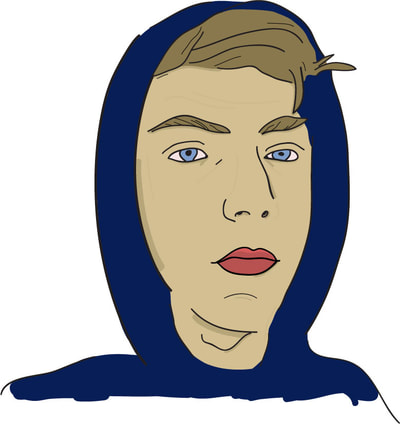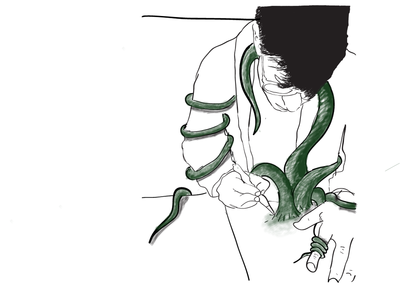|
I started my graphic design 1 students on Adobe Photoshop CS6 standard version first. Eventually we started to move into Adobe Illustrator and this is a fun lesson to teach students the basics of Illustrator. Since Photoshop and Illustrator are very different programs, I informed my students ahead of time that this would be a another learning curve-- that some students might catch on quickly, while others might need more practice. Last year, I won a $4000 grant to purchase tech for our graphic design program from the Centurylink Grant award program. I purchased 36 small Wacom drawing tablets for students to use and I instructed my graphic design 2 students to use them for this illustrator sefie project. First, students took a selfie using their phone or one of my classroom cameras. I instructed students that their face had to be showing, but the artistic style, color, line quality, was up to them. I also told students they could change their selfie to an "alter-ego" which made for some very interesting changes to their actual look. This tutorial below by RiceGum on Youtube is both entertaining and informative & we watched the video as a class and then I posted it to the graphic design 2 google classroom for students to reference. When I first taught this lesson, I was worried that it would be too "tracey" and boring for my more advanced students, but it ended up being really okay! Since I allowed students much creative freedom, they were able to really have fun with it. I even had a girl turn herself into a werewolf! After everyone was finished, I created a simple google slides slideshow of each student's selfie to share with the class and I plan on sharing them with future graphic design classes. It was fun having the students guess who each person was! Check out additional examples of graphic design 2 students illustrator selfies below:
0 Comments
 This project was quite extensive, but one of my favorite projects I have ever taught! We spent a day having a class discussion about the work of Shepard Fairey and the way Shepard Fairey uses visual art as a way to draw attention to a particular social issue such as pollution, inequality, and greed. We also talked about the works of Banksy and Ricardo Levins Morales (Minneapolis-based activist artist). We listened to a Podcast interview of Ricardo and his work. Listen to the podcast of Ricardo Levins Morales on MPR here. Students were first asked to brainstorm different social issues. At first, some students really struggled thinking of ideas. For the kids who struggled, I asked them what they liked. For example, a student said he liked music. I asked him if he knew of any problems in the music industry. He immediately said "Piracy", "Inequality", "Sexism" and "People need to support local music more". These are all great examples of social issues that tie into a student interest. Some examples of social issues chosen by students for this project include marriage equality, racial equality, saving and protecting animals, recycling, protecting the environment, religious equality, self esteem, perfectionism, anti-bullying, and greed. One issue I did run into was I had one student who wanted to do a design based around legalizing marijuana. Even though I personally didn't find this offensive, I knew it would be an issue since I teach at a public school! Drugs are bad...mmmk? So I had to explain to the student that while I am all for freedom of expression, that I would appreciate it if he chose a different, more school appropriate topic. I dislike the idea of censorship in my classroom, but there's got to be a line drawn somewhere, right? Next, students were given the challenge of illustrating that social issue. The goal was to create a design that clearly illustrated the chosen social issue. Some students did better at this than others. Each student had to show me their design plan in order to get their linoleum. Students used a 6B ebony pencil to outline their design plan, flip the plan on top of the linoleum, and burnish the design onto the linoleum. This helped students keep their words & letters backwards when carving without having to worry about writing the letters and words backwards. Finally, students started carving their designs! View my demo video below for complete instructions. Students were asked to create 6 different prints and choose 3 for display. After they finished preparing their prints for exhibit, they were asked to write an artist statement. Two of the guiding questions for their artist statement was "How can art change the world?" and "What is visual art's relationship to society?". Some of the responses I got were truly inspiring. Overall, I loved this project and how it engaged all of my students! |
Mrs. QuamThis is my 11th year teaching art & graphic design! I have taught middle school for 2 years and high school for almost 5 years. I truly enjoy working with students on a daily basis. I also enjoy teaching real-world skills such as problem solving, using technology, and the power of teamwork and collaboration. My joy is sharing my passion for art with others! Archives
March 2024
Categories
All
|
Photo from Rob Qld



























 RSS Feed
RSS Feed

